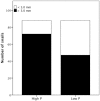Response to phosphorus limitation varies among lake populations of the freshwater snail Potamopyrgus antipodarum
- PMID: 24454936
- PMCID: PMC3894190
- DOI: 10.1371/journal.pone.0085845
Response to phosphorus limitation varies among lake populations of the freshwater snail Potamopyrgus antipodarum
Abstract
Local adaptation--typically recognized as higher values of fitness-related traits for native vs. non-native individuals when measured in the native environment--is common in natural populations because of pervasive spatial variation in the intensity and type of natural selection. Although local adaptation has been primarily studied in the context of biotic interactions, widespread variation in abiotic characteristics of environments suggests that local adaptation in response to abiotic factors should also be common. Potamopyrgus antipodarum, a freshwater New Zealand snail that is an important model system for invasion biology and the maintenance of sexual reproduction, exhibits local adaptation to parasites and rate of water flow. As an initial step to determining whether P. antipodarum are also locally adapted to phosphorus availability, we examined whether populations differ in their responses to phosphorus limitation. We found that field-collected juvenile P. antipodarum grew at a lower rate and reached an important size threshold more slowly when fed a relatively low vs. a relatively high-phosphorus diet. We also detected significant across-population variation in individual growth rate. A marginally significant population-by-dietary phosphorus interaction along with a two-fold difference across populations in the extent of suppression of growth by low phosphorus suggests that populations of P. antipodarum may differ in their response to phosphorus limitation. Local adaptation may explain this variation, with the implication that snails from lakes with relatively low phosphorus availability should be less severely affected by phosphorus limitation than snails from lakes with higher phosphorus availability.
Conflict of interest statement
Figures


Similar articles
-
Phosphorus availability in the source population influences response to dietary phosphorus quantity in a New Zealand freshwater snail.Oecologia. 2017 Dec;185(4):595-605. doi: 10.1007/s00442-017-3983-4. Epub 2017 Oct 23. Oecologia. 2017. PMID: 29058123
-
Sensitivity to dietary phosphorus limitation in native vs. invasive lineages of a New Zealand freshwater snail.Ecol Appl. 2016 Oct;26(7):2218-2224. doi: 10.1002/eap.1372. Epub 2016 Sep 20. Ecol Appl. 2016. PMID: 27755737
-
Sensitivity to phosphorus limitation increases with ploidy level in a New Zealand snail.Evolution. 2013 May;67(5):1511-7. doi: 10.1111/evo.12026. Epub 2013 Jan 4. Evolution. 2013. PMID: 23617926
-
Phosphorus-mediated changes in life history traits of the invasive New Zealand mudsnail (Potamopyrgus antipodarum).Oecologia. 2010 Jul;163(3):549-59. doi: 10.1007/s00442-009-1522-7. Epub 2009 Dec 22. Oecologia. 2010. PMID: 20033217
-
Prosobranch snails as test organisms for the assessment of endocrine active chemicals--an overview and a guideline proposal for a reproduction test with the freshwater mudsnail Potamopyrgus antipodarum.Ecotoxicology. 2007 Feb;16(1):169-82. doi: 10.1007/s10646-006-0106-0. Ecotoxicology. 2007. PMID: 17219090 Review.
Cited by
-
Phosphorus availability in the source population influences response to dietary phosphorus quantity in a New Zealand freshwater snail.Oecologia. 2017 Dec;185(4):595-605. doi: 10.1007/s00442-017-3983-4. Epub 2017 Oct 23. Oecologia. 2017. PMID: 29058123
-
Asexuality Associated with Marked Genomic Expansion of Tandemly Repeated rRNA and Histone Genes.Mol Biol Evol. 2021 Aug 23;38(9):3581-3592. doi: 10.1093/molbev/msab121. Mol Biol Evol. 2021. PMID: 33885820 Free PMC article.
-
Evidence for stronger discrimination between conspecific and heterospecific mating partners in sexual vs. asexual female freshwater snails.PeerJ. 2022 Nov 24;10:e14470. doi: 10.7717/peerj.14470. eCollection 2022. PeerJ. 2022. PMID: 36447513 Free PMC article.
-
Effects of polyploidy and reproductive mode on life history trait expression.Ecol Evol. 2016 Jan 11;6(3):765-78. doi: 10.1002/ece3.1934. eCollection 2016 Feb. Ecol Evol. 2016. PMID: 26865964 Free PMC article.
-
Distinct Bacterial Microbiomes in Sexual and Asexual Potamopyrgus antipodarum, a New Zealand Freshwater Snail.PLoS One. 2016 Aug 26;11(8):e0161050. doi: 10.1371/journal.pone.0161050. eCollection 2016. PLoS One. 2016. PMID: 27563725 Free PMC article.
References
-
- Williams GG (1966) Adaptation and natural selection: a critique of some current evolutionary thought. Princeton University Press. 307 p.
-
- Endler JA (1986) Natural selection in the wild. Princeton University Press. 337 p.
-
- Gandon S, Van Zandt P (1998) Local adaptation and host-parasite interactions. Trends Ecol Evol 13: 214–216. - PubMed
-
- Laukkanen L, Leimu R, Muola A, Salminen J-P, Mutikainen P (2012) Plant Chemistry and local adaptation of a specialized folivore. PLoS ONE 7: e38225 doi:10.1371/journal.pone.0038225 - DOI - PMC - PubMed
-
- Reznick D, Endler JA (1982) The impact of predation on life history evolution in Trinidadian guppies (Poecilia reticulata). Evolution 36: 160–177. - PubMed
Publication types
MeSH terms
Substances
LinkOut - more resources
Full Text Sources
Other Literature Sources
Research Materials

